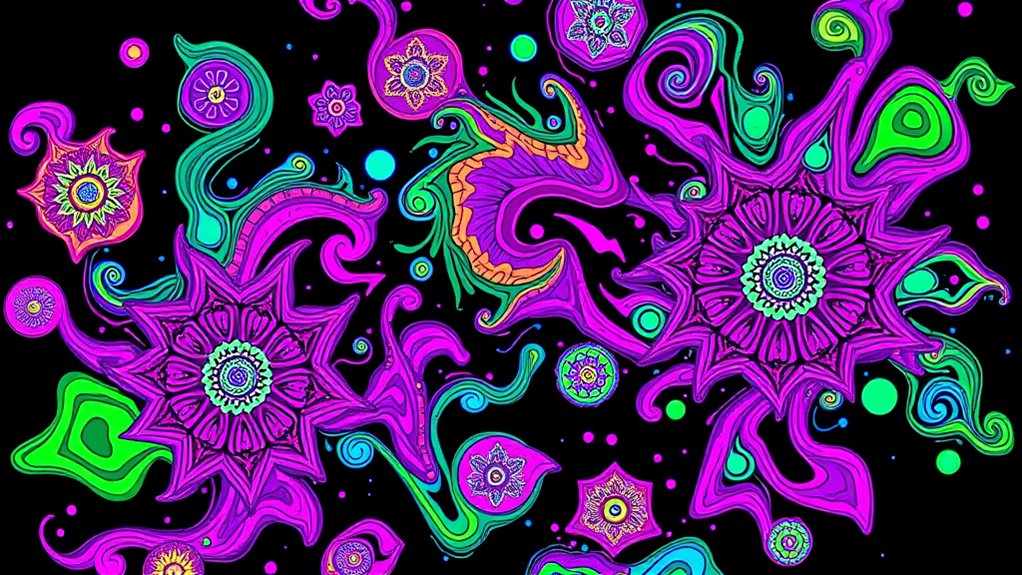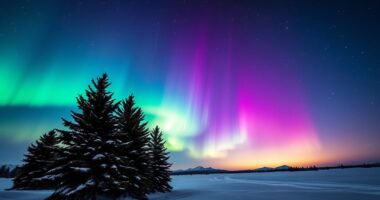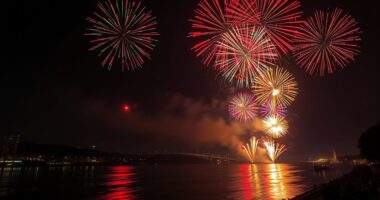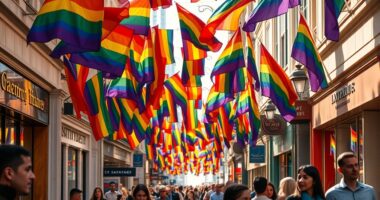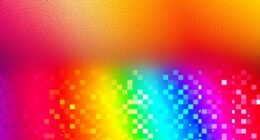Psychedelic blacklight art of the 1960s transforms everyday surfaces into luminous, surreal canvases filled with swirling, fractal-like patterns that glow vividly under UV light. It uses fluorescent paints to create vibrant, pulsating designs that evoke motion, energy, and altered perception. These hypnotic visuals often feature vibrant neon colors and complex, kaleidoscopic patterns that capture the spirit of the era’s experimentation and freedom. If you continue exploring, you’ll uncover more about this mesmerizing art style and its cultural significance.
Key Takeaways
- Features vibrant, glowing designs created with fluorescent paints that re-emit UV light, making artwork appear luminous under blacklight.
- Incorporates intricate, swirling patterns, fractals, and kaleidoscopic motifs typical of 1960s psychedelic art.
- Reflects the counterculture movement’s themes of freedom, altered perception, and experimental exploration.
- Commonly seen in posters, album covers, and clothing, adding a surreal and immersive visual experience.
- Uses shimmering, pulsating colors to evoke movement, energy, and a sense of otherworldly dimension.
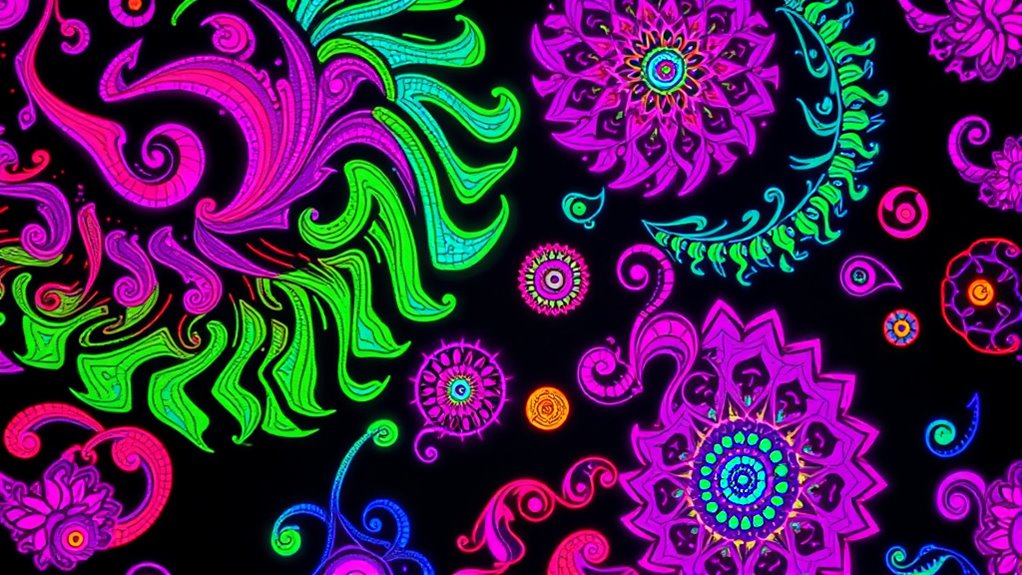
Blacklight art of the 1960s transformed the visual landscape with its vibrant, glowing designs that seemed to come alive under ultraviolet light. When you step into a room illuminated by blacklights, you immediately notice how the colors burst into luminous life. This art style uses glow effects to create an otherworldly atmosphere, making everything appear surreal and mesmerizing. As you focus on the artwork, you see how the colors aren’t just bright—they seem to pulse and shimmer, adding depth and movement to static images. The glow effects are achieved through fluorescent paints that absorb ultraviolet light and re-emit it, giving the art its signature radiant quality. This technique invites you to experience visuals in a way that’s immersive and dynamic, transforming ordinary surfaces into vibrant canvases.
Psychedelic patterns are at the core of blacklight art from the 1960s. These patterns are characterized by their intricate, swirling designs and their ability to evoke a sense of motion and fluidity. As you observe these patterns, you notice how they often feature fractal-like shapes, spirals, and waves that seem to breathe and shift. The psychedelic patterns are intentionally complex, engaging your eye and mind simultaneously, creating a sense of expanded consciousness. The vibrant colors in these patterns—neon pinks, electric blues, luminous greens—are carefully chosen to amplify the visual impact under blacklight. The combination of glow effects and psychedelic patterns results in images that aren’t static but alive with energy. You can almost feel the movement, as if the artwork is pulsating in harmony with music, which was a common pairing at the time.
This style of art was more than just visual decoration; it was a form of expression that captured the spirit of the 1960s counterculture. You might have seen it in posters, album covers, or even on clothing, all designed to evoke a sense of freedom, experimentation, and altered states of perception. The psychedelic patterns, with their hypnotic spirals and kaleidoscopic symmetry, invited you to explore a universe beyond the ordinary. The glow effects intensified this experience, making the artwork seem to glow from within, blurring the line between art and living experience. When you’re immersed in blacklight art, you’re not just looking at images—you’re stepping into a vibrant, surreal world that celebrates the psychedelic era’s bold visual language.
Additionally, the use of fluorescent paints in blacklight art of the 1960s played a crucial role in enhancing the luminous effects, making the artwork more captivating and engaging.
Frequently Asked Questions
What Materials Were Most Commonly Used in 1960S Blacklight Art?
You’ll find that fluorescent paints and UV reactive materials were most commonly used in 1960s blacklight art. These materials glow vividly under ultraviolet light, creating mesmerizing visuals. Artists often applied fluorescent paints to posters, clothing, and murals, enhancing the psychedelic experience. The use of UV reactive materials allowed for vivid, glowing effects that defined the era’s vibrant, experimental aesthetic, making their artwork truly stand out under blacklights.
How Did Blacklight Art Influence 1960S Psychedelic Music Posters?
Imagine if your favorite Spotify playlist from 1969 suddenly played through a vintage blacklight—that’s how blacklight art influenced psychedelic music posters. Its vibrant colors and swirling patterns became central to psychedelic poster design, creating immersive visual experiences. This influence helped artists evoke the era’s wild, mind-expanding vibe, making concert posters as much a piece of art as the music itself, and shaping the psychedelic aesthetic we still admire today.
Were There Any Notable Blacklight Art Pioneers Besides Artists?
Yes, besides artists, blacklight art entrepreneurs and exhibition organizers played key roles. You might explore figures who promoted and showcased blacklight art, helping it gain popularity beyond individual creations. These entrepreneurs organized events and exhibitions, making blacklight art more accessible and influential in the 1960s counterculture scene. Their efforts helped shape the movement, fostering a broader appreciation and integration of blacklight art into music, fashion, and social gatherings.
How Did Blacklight Art Impact 1960S Counterculture Movements?
You might think blacklight art just looked cool, but it profoundly shaped 1960s visual culture and societal impact. By creating immersive, mind-bending environments, it fueled the counterculture’s desire for freedom and experimentation. This art form challenged traditional aesthetics, encouraging self-expression and unity in movements like peace protests and music festivals. Its vibrant, surreal visuals helped define the era’s rebellious spirit, making blacklight art a powerful symbol of societal change.
What Techniques Distinguished Blacklight Art From Traditional Psychedelic Art?
You notice that blacklight art stands out from traditional psychedelic art because it uses glowing effects created by fluorescent pigments. These pigments absorb ultraviolet light and emit vibrant, glowing colors that seem to pulse and shift under blacklights. Unlike traditional methods, blacklight art relies heavily on these luminous effects to create immersive, otherworldly visuals, making it a signature technique that defines its unique, mesmerizing aesthetic.
Conclusion
As you step into the vibrant world of 1960s blacklight art, you can’t help but feel like you’re entering a psychedelic universe where colors explode like fireworks and shapes dance like wild spirits. This art isn’t just visual—it’s a mind-bending journey that totally rewires your perception. Dive deep into this kaleidoscopic madness, and you’ll find yourself forever changed, living in a world where blacklights turn reality into an endless, glowing carnival of wonder.
